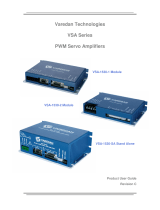
PMAC2A PC104 Hardware Reference Manual
Table of Contents i
Table of Contents
INTRODUCTION .......................................................................................................................................................1
Board Configuration..................................................................................................................................................1
Base Version .........................................................................................................................................................1
Board Options ...........................................................................................................................................................1
Option 2A: PC/104 Bus Stack Interface ..............................................................................................................1
Option 5xF: CPU Speed Options.........................................................................................................................1
Option 6: Extended Firmware Algorithm ............................................................................................................1
Option 6L: Multi-block Lookahead Firmware.....................................................................................................1
Option 10: Firmware Version Specification.........................................................................................................2
Option 12: Analog-to-Digital Converters.............................................................................................................2
Additional Accessories..............................................................................................................................................2
Acc-1P: Axis Expansion Piggyback Board...........................................................................................................2
Acc-2P: Communications Board .........................................................................................................................2
Acc-8TS Connections Board.................................................................................................................................3
Acc-8ES Four-Channel Dual-DAC Analog Stack Board......................................................................................3
Acc-8FS Four-Channel Direct PWM Stack Breakout Board................................................................................3
HARDWARE SETUP .................................................................................................................................................5
Clock Configuration Jumpers....................................................................................................................................5
Reset Jumpers............................................................................................................................................................5
CPU Configuration Jumpers .....................................................................................................................................6
Communication Jumpers...........................................................................................................................................6
ADC Configuration Jumpers.....................................................................................................................................6
Encoder Configuration Jumpers................................................................................................................................6
Single-Ended Encoders.........................................................................................................................................6
Differential Encoders............................................................................................................................................6
MACHINE CONNECTIONS.....................................................................................................................................9
Mounting ...................................................................................................................................................................9
Power Supplies..........................................................................................................................................................9
Digital Power Supply............................................................................................................................................9
DAC Outputs Power Supply .................................................................................................................................9
Flags Power Supply............................................................................................................................................10
Overtravel Limits and Home Switches....................................................................................................................10
Types of Overtravel Limits..................................................................................................................................10
Home Switches....................................................................................................................................................10
Motor Signals Connections .....................................................................................................................................10
Incremental Encoder Connection .......................................................................................................................10
DAC Output Signals ...........................................................................................................................................11
Pulse and Direction (Stepper) Drivers ...............................................................................................................11
Amplifier Enable Signal (AENAx/DIRn).............................................................................................................11
Amplifier Fault Signal (FAULT-) .......................................................................................................................12
Optional Analog Inputs ...........................................................................................................................................12
Compare Equal Outputs ..........................................................................................................................................12
Serial Port (JRS232 Port) ........................................................................................................................................12
Machine Connections Example: Using Analog ±10V Amplifier ............................................................................13
Machine Connections Example: Using Pulse and Direction Drivers ......................................................................14
SOFTWARE SETUP ................................................................................................................................................15
PMAC I-Variables...................................................................................................................................................15
Communications......................................................................................................................................................15
Operational Frequency and Baud Rate Setup ....................................................................................................15
Filtered DAC Output Configuration........................................................................................................................16
Parameters to Set up Global Hardware Signals.................................................................................................17
Parameters to Set Up Per-Channel Hardware Signals ......................................................................................18






















